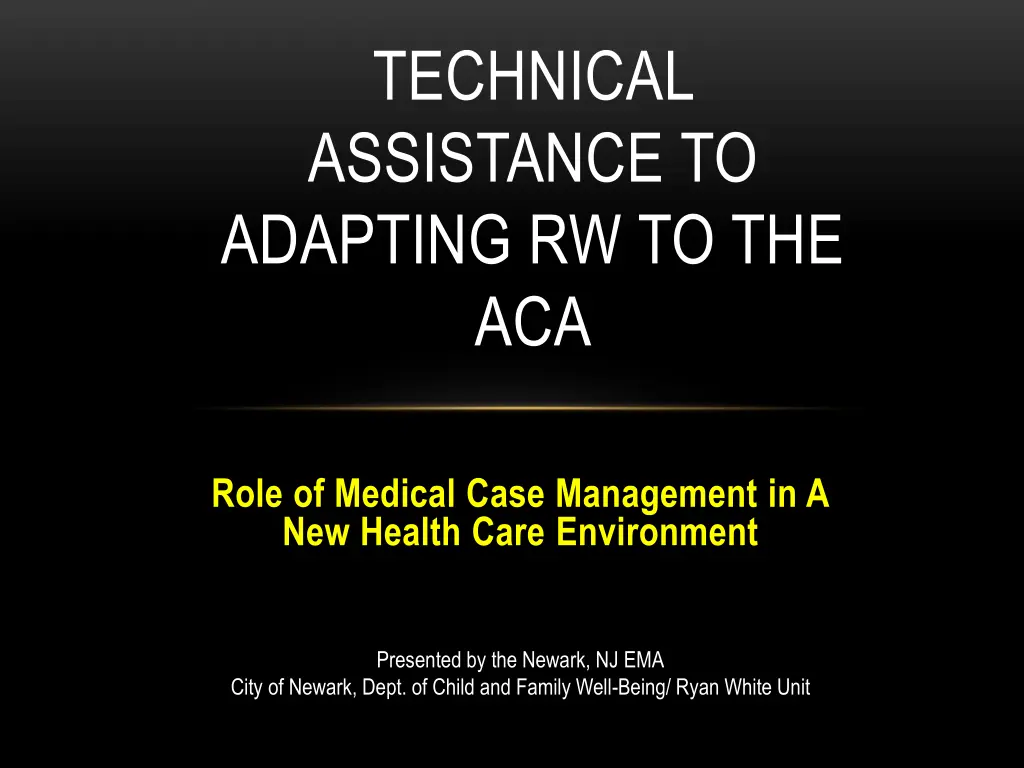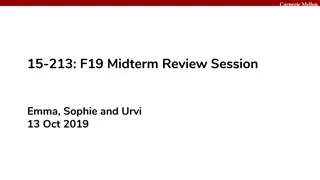
Role of Medical Case Management in Healthcare Environment
Explore the impact of the Affordable Care Act on medical case management in the healthcare environment, focusing on strategies, coordination of care, and enhancing the vision of the Ryan White HIV/AIDS Program. Understand key provisions of the ACA, its impact on RW recipients in NJ, and learn about MCM tools and strategies for effective implementation.
Download Presentation

Please find below an Image/Link to download the presentation.
The content on the website is provided AS IS for your information and personal use only. It may not be sold, licensed, or shared on other websites without obtaining consent from the author. If you encounter any issues during the download, it is possible that the publisher has removed the file from their server.
You are allowed to download the files provided on this website for personal or commercial use, subject to the condition that they are used lawfully. All files are the property of their respective owners.
The content on the website is provided AS IS for your information and personal use only. It may not be sold, licensed, or shared on other websites without obtaining consent from the author.
E N D
Presentation Transcript
TECHNICAL ASSISTANCE TO ADAPTING RW TO THE ACA Role of Medical Case Management in A New Health Care Environment Presented by the Newark, NJ EMA City of Newark, Dept. of Child and Family Well-Being/ Ryan White Unit
TECHNICAL ASSISTANCE TO ADAPTING RW TO THE ACA- ROLE OF MEDICAL CASE MANAGEMENT IN A NEW HEALTH CARE ENVIRONMENT Workshop Faculty Ketlen Alsbrook, MPA- Newark EMA Project Director Shanon Mettlen, MPA- Union County Grant Coordinator Sharon Postel, MBA, JD- QM Consultant
SUPPORT DISCLOSURES This continuing education activity is managed and accredited by Professional Education Service Group. The information presented in this activity represents the opinion of the author(s) or faculty. Neither PSEG, nor any accrediting organization endorses any commercial products displayed or mentioned in conjunction with this activity. Commercial Support was not received for this activity.
FACULTY DISCLOSURES Ketlen Alsbrook Has no financial interest or relationship to disclose Shanon Mettlen Has no financial interest or relationship to disclose Sharon Postel Has no financial interest or relationship to disclose CME Staff Disclosures Professional Education Services Group staff have no financial interest or relationships to disclose.
LEARNING OBJECTIVES At the conclusion of this activity, the participant will be able to: 1. Examine the role of MCM in the current and new healthcare environment. 2. Identify how RW CLD and CQM systems can enhance coordination of care and NHAS efforts. 3. Develop MCM strategies and tools to continue and enhance the vision of the RWHAP
AFFORDABLE CARE ACT Key provisions: Universal coverage; mandates provision/ acquisition of health insurance Eliminates annual/ lifetime limits on coverage and exclusion of those w/ pre-existing conditions Premiums must cover at least 80% of medical care costs and include preventive care State chosen benchmark plan covering 10 federally mandated health categories. Accountability Care Organizations (quality, efficiency & cost per pt) May reduce uninsured from 19% to 8%
IMPACT ON NEMA RW RECIPIENTS NJ Medicare Eliminates Part D donut hole and overpayments No copay or deductible for preventive care 12% of Part A/F recipients have Medicare New Jersey Medicaid Expands income limits from 78% to 133% FPL. 1/3 of Part A/F recipients have some form of Medicaid Add l 3,300 clients eligible for Medicaid after expansion (165% increase from 2.5K to 5.3K). Insurance Exchanges Managed care programs for individuals and employers with >50 workers Out of pocket costs on a sliding scale of 2% to 9.5% of annual income Approx. 1,000 Part A/F clients (134% - 500% of FPL) may be covered
NEMA EPIDEMIOLOGICAL PROFILE 13,476 PLWHA 2 million population 69% Afr Amer, 17% Hispanic/Latino, 12% White 40% female Heterosexual, IDU, MSM exposure 5 counties in northern NJ urban, suburban/rural Only EMA in NJ. (3 TGAs + Philadelphia PA EMA which covers part of NJ) EMA has 38% NJ PLWHA but only 24% NJ population Newark 5,858 PLWHA of 277,000 population 2.1% prevalence vs. 0.4% US 16% of NJ epidemic but 3% of population
WHERE WE WERE (PRE- RWTEA) CASE MANAGEMENT 30 CASE MANAGEMENT AGENCIES serving 6,000 clients. CM definition included both medical and non-medical functions. Agencies could do medical OR non-medical OR both. Hybrid.
CASE MANAGEMENT DEFINITION (PRE- RWTEA) A range of client-centered services that links clients with primary medical care, psychological and other services to ensure timely, coordinated access to medically-appropriate levels of health and support services, continuity of care, ongoing assessment of the client s and other family members needs and personal support systems and inpatient case management services that prevent unnecessary hospitalization or that expedite discharge, as medically appropriate, from inpatient facilities. Key activities include initial comprehensive individualized service plan; coordination of services required to implement the plan; client monitoring to assess the efficacy of the plan; and periodic reevaluation and revision of the plan as necessary over the life of the client. May include client-specific advocacy and/or review of utilization of services. (See Case Management Standards document for more detailed information regarding case management services).
WHERE DID WE WANT TO GO? All CM agencies had to be split by new DISTINCT functions FROM OVERLAPPING FUNCTIONS. CARE Act Case Management RWTMA Medical Case Management RWTMA Non-Medical Case Management
HOW WE PREPARED Medical Case Management Client Level Data (CLD) System Quality Management Programmatic & Fiscal Monitoring Ongoing scan of healthcare environment (pre- ACA)
CLEAR DEFINITION AND RESPONSIBILITIES FOR CM-NM AND MCM CASE MANAGEMENT- NON MEDICAL MEDICAL CASE MANAGEMENT Must be provided by trained professionals (medically credentialed and otherwise) Advice and assistance in obtaining medical, social, community, legal, financial, and other needed services. Timely/ Coordinated care plans that link clients to medical care, psychosocial and other services Non-medical case management does not involve coordination and follow-up of medical treatments. Initial assessment Development of care plan Coordination of services Continuous monitoring Periodic re-evaluation and adaptation Continuity of care Treatment adherence counseling
PROGRAM CHANGES MCM = Medical providers only (approx. 15 agencies) PMC providers must apply for or demonstrate provision of MCM CM-NM = CBOs, non-medical agencies (15 additional agencies) Exceptions= Partnerships/Collaborations Allows experienced CM agencies to do MCM for small medical providers who cannot support (FT/PT) MCM staff. Planning Council updates to Standards of Care for PMC & CM-NM Train MCM and CM-NM staff on expectations, responsibilities, etc. Provide ongoing training.
CONCERNS Not all CM agencies could do MCM. 75%-25% split core medical services (MCM) and support (CM-NM) CBOs were concerned about funding. Shifting of RW resources to non community based providers. Sustaining CM programs that exceed CM expectations
BENEFITS Reduce duplication of effort. Retain high performing agencies. Attainable goals; realistic expectations More effective system MCM have support of [CM- NM] agencies with more knowledge of community resources.
INFORMATION TECHNOLOGY (IT) CLD Nuclear Option (Payor of Last resort controls) Referral tracking system to improve coordination between RW and non-RW providers 9-month alert for follow up/ retention in care. Exception report for MMC, Medicare, lost clients, etc. Automated feed of EMR to CLD. CHAMP user subcommittee
OTHER QUALITY MANAGEMENT TOOLS Newark EMA CQM Plan HRSA HAB Core Clinical Performance Measures Expand from 5 measures to Group 1, 2 , 3 and In+Care Extend required fields from PMC to MCM (most likely to enter/record data) Performance measurement and monitoring using RSR Ready Vendor System. Expand CQM Chart reviews Adding MCM in addition to PMC Early Intervention and Retention Collaboratives (EIRCS)
OUR MCM VISION MCMs as integral part of care system Interventions- patients new, existing and lost to care Benefits Coordination MCM support of all PLWHA receiving PMC regardless of patient s source of insurance. MCM as the focal point of IT system. Shift from PMC OR in addition to PMC. (HAB Performance Indicators)
MCM SCOPE ENTRY INTO CARE Identify, Inform, Referral and Linkage (EIIHA and EIRCS) ENGAGEMENT IN CARE Development of care plan, follow up, treatment plan updates RETENTION IN CARE. Filling in gaps, navigating the system, insurance affordability TREATMENT ADHERENCE Keeping appointments, medical monitoring (CD4, VL, medication regimen & complications), VL Suppression
FY 13 Newark EMA Ryan White Part A Program BENEFITS COORDINATION INITIATIVE Updated: 9/11/12 BENEFITS COORDINATION TEMPLATE This template can be used for 3 purposes: 1/ As an individualized care plan checklist for each client. (Service columns only.) 2/ For an individual client, to determine funding source of benefits and needed coordination between funding programs. 3/ For an agency to determine total resources available and needed by funding source SERVICE NEED Needed? Funding Source Service Type General Subtype Y N MMC Medi- caid G Medi-care VA Pvt Ins Charity RW A RW B RW C 1 Medical Care Outpatient Physician visit Nurse visit Labs Inpatient Long Term care 2 HIV Medications ADDP APA Other 3 Mental Health Outpatient Inpatient 4 Substance Abuse Outpatient Residential Inpatient 5 Oral Health 12 Housing Emergency Transitional Long Term 13 Food Delivered Meals Food Bags Food Vouchers 14 Financial Assist. Emergency Financial Benefits 15 Legal Assist. 16 Respite Care
CHALLENGES Uncertainty Relationships with Medicaid managed care, HMO s, etc. Referrals from PCP to access specialty care Copays, deductibles, etc. Prior authorization for non- HIV medications, treatments, etc. Decreased CQM controls
PROGRAM & FISCAL MONITORING Implementation of National Monitoring Standards Assessing the landscape Use of CLD for monitoring program and fiscal performance Modifications to Site Visit format, program assessments and corrective actions (more PDSA s).
NEXT STEPS Prepare for seismic shift from RW PMC to MMC. Assess the landscape Standardized MCM functions Review/ update MCM Training curriculum Make training available to CM-NM providers. Review/ update RSR Ready Vendor System as needed Benefits Coordination Initiative Develop relationships with NJ Medicaid, managed care programs, ACO s, etc.
OBTAINING CME/CE CREDIT If you would like to receive continuing education credit for this activity, please visit: http://www.pesgce.com/RyanWhite2012

